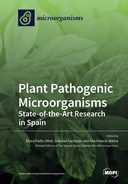Explore

Plant Pathogenic Microorganisms: State-of-the-Art Research in Spain
0 Ungluers have
Faved this Work
Login to Fave
Pathogenic microorganisms, including fungi, oomycetes, bacteria, viruses, and viroids, constitute a serious threat to agriculture worldwide. In Spain, one of the countries with the highest proportion of agricultural gross domestic product in Europe, the agri-food industry is the main manufacturing activity. Consequently, the presence and emergence of microorganisms causing serious plant diseases to economically important crops is especially relevant. In line with this, Spain has an important number of research groups interested in plant pathology, with scientists working on many aspects of pathogenic microorganism–plant interactions, from the basic aspects to more applied studies. In recent years, numerous important advancements have been achieved by scientists working in Spain in terms of the biological and molecular characterization of plant pathogenic microorganisms, in elucidating mechanisms of microbe pathogenesis, plant resistance to microbe infection, and plant–microbe–vector interactions. All these new achievements have provided essential knowledge for agricultural researchers worldwide.The aim of this Special Issue was to provide a platform for Spanish researchers interested in plant pathogenic microorganisms to share their recent results related to microbe–plant host interactions, microbe–vector interactions, microbe–microbe interactions, evolution, ecology, and control strategies.
This book is included in DOAB.
Why read this book? Have your say.
You must be logged in to comment.
Rights Information
Are you the author or publisher of this work? If so, you can claim it as yours by registering as an Unglue.it rights holder.Downloads
This work has been downloaded 78 times via unglue.it ebook links.
- 78 - pdf (CC BY) at Unglue.it.
Keywords
- agroinoculation
- Alternaria fruit spot
- Alternaria leaf blotch
- bacterial and fungal plant diseases
- bacterial biological control agents
- bacterial motility
- bacterial wilt
- Bactericera trigonica
- bacterium
- begomoviruses
- Biology, Life Sciences
- biopesticides
- canker
- Citrus
- dieback
- Disease
- Environmental stress
- ethanol contamination
- Geminiviridae
- Global warming
- HLB
- improvement
- infectious clone
- inoculum management
- invasive pathogens
- Lasiodiplodia brasiliensis
- LOPAT
- lytic peptides
- mastrevirus
- Mathematics & science
- MCPs
- methyl-accepting chemotaxis proteins
- Microbiology (non-medical)
- n/a
- Neofusicoccum australe
- Neofusicoccum cryptoaustrale
- Neofusicoccum luteum
- Neofusicoccum parvum
- Neofusicoccum stellenboschiana
- overlapping genes
- pathogenic bacteria
- pathogenicity
- pathogenicity islands
- pectinolytic activity
- Persea americana
- Phaseolus vulgaris
- Philaenus spumarius
- phylogenetic analysis
- phytosanitary measures
- plant defense
- Pseudomonas viridiflava
- rate of evolution
- Reference, information & interdisciplinary subjects
- Research & information: general
- Risk assessment
- screening
- spore release
- ssDNA viruses
- stem-end rot
- sweet potato
- synthetic peptides
- thema EDItEUR::G Reference, Information and Interdisciplinary subjects::GP Research and information: general
- thema EDItEUR::P Mathematics and Science::PS Biology, life sciences
- thema EDItEUR::P Mathematics and Science::PS Biology, life sciences::PSG Microbiology (non-medical)
- Trichoderma
- VBNC
- Vector
- vector-borne disease
- xanthomonads
Links
DOI: 10.3390/books978-3-0365-7338-0Editions

